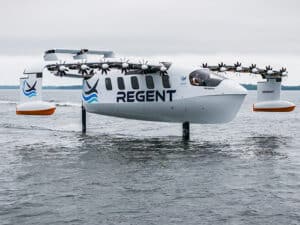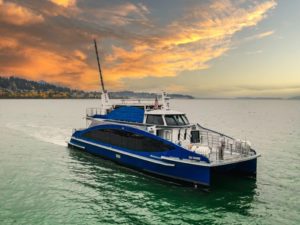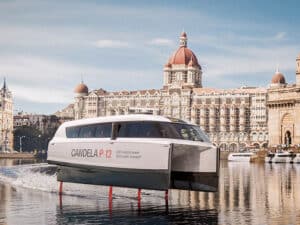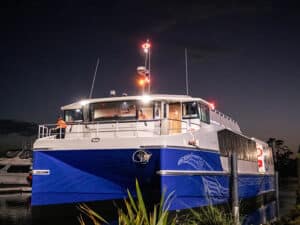
Chinese yard launches first of two new rail ferries for U.S. operator
Written by Nick Blenkey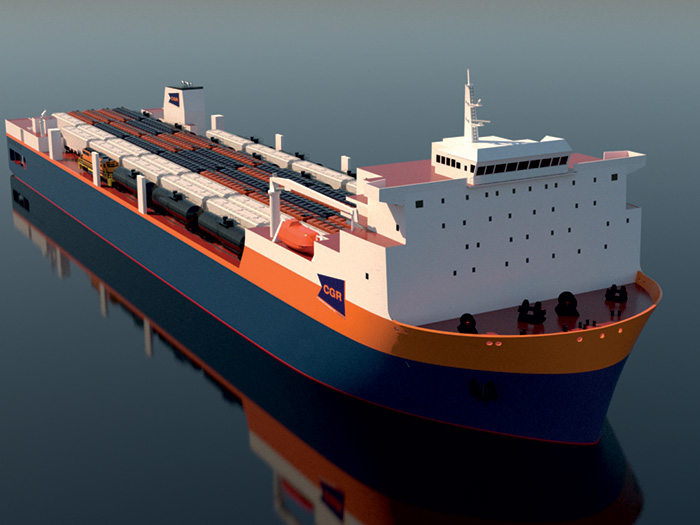
The newly launched vessel is expected to begin operations in the second quarter of 2021, with the second new vessel expected in the third quarter.
China’s CSSC Huangpu Wenchong Shipbuilding Company has launched the first of two new rail ferries for Jacksonville, Fla., headquartered CG Railway (CGR).
The ferries, the first of which is set to start operations in the second quarter of next year, will replace CGR’s two existing vessels, which have transported over 200,000 railcars in more than 1,400 sailings between Mobile, Ala., and Coatzacoalcos, Mexico, since 2001.
Those ships, the 1982-built Bali Sea and Banda Sea, fly the Singapore flag and are managed by SEACOR group member Seabulk.
CGR is part of a joint venture between subsidiaries of SEACOR Holdings and Genesee & Wyoming Inc. and operates a U.S. Class III freight railroad transporting approximately 10,000 annual carloads of diversified commodities across the Gulf of Mexico.
The trip across the Gulf currently takes approximately five days, or half the time required for the overland route. The new, 590-foot-long ferries are designed to carry 135 railcars each, up from 115 railcars on the existing ferries, with an expected top speed of 14 knots, up from seven knots. With their additional capacity, and faster speed enabling more sailings per month, the new vessels increase CGR’s potential annual carload capacity by 40%.
“These innovative new vessels are purpose-built to provide increased reliability, speed and fuel efficiency and will materially expand the number of annual railcar spaces we can offer customers,” says CGR President Hoffman Lijeron. “Their capacity, efficient hull design, articulated rudders and modern, slow-speed engines will significantly reduce the vessels’ environmental footprint. In fact, compared with a traditional all-rail route from Mobile to Mexico City, shipping via the new CGR vessels and Ferromex is expected to provide a 44% reduction in CO2 emissions per ton/mile versus the all-rail route.”

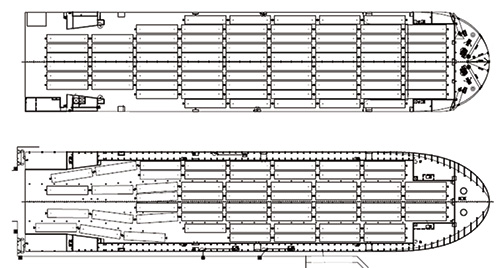
The ferries will depart for the U.S. after completing testing and sea trials.
The new ships are likely among the first built with features designed to cope with a pandemic, including segregated passageways for pilots and other visitors, as well as spaces with separate HVAC systems to quarantine crew.
“We’re trying to anticipate all the potential scenarios we could have in the next 20 to 30 years,” Lijeron explains. “If there is anything we’ve learned from the past year, it’s the value of protecting our customers’ supply chains from potential disruptions.
“CGR offers tremendous potential for customers—connecting five Class I railroads and a G&W short line in Mobile to Ferromex in Coatzacoalcos—and I’m excited to lead its growth as a much faster alternative to the traditional land route,” Lijeron continues. “Our investment in constructing these two state-of-the-art vessels is a clear indication of our commitment to becoming the premium freight transportation provider between the United States, Canada and central and southern Mexico.”
The ships will have the following particulars:
- Length: 180 meters (590’)
- Length BP: 176.8 meters (580’)
- Breadth: 36.6 meters (120’)
- Depth 10 meters (32’ 10”)
- Summer Load Line Draft: 6.9 meters (22’ 8”)
- Design Draft: 6.7 meters (22’)
- Gross Registered Tonnage: 30,102 (est)
- Net Registered Tonnage: 9,031 (est)
- Deadweight (Design Draft): 18,950 tonnes
- Deadweight (Summer Load Line Draft): 20,210 tonnes
- Capacity Railcars: 135 x 57-foot cars
- Max Car Weight: 130 tonnes, with higher weights and/or dimensional loads accommodated with the proper railcar
- Fuel Oil: 2,695 cubic meters
- Ballast: 29,879 cubic meters
- Service Speed: 14 knots
- Range: >20,000 miles
- Accommodations: Crew of 28
- Propulsion: twin screw, slow speed diesel engines rated at 4,800 kWMCR with controllable pitch propellers
- Generators: Three diesel-driven generators one rated at 1,330 kW and two rated at 1,164 kW
- Classes of Dangerous Goods: IMDG Class 1.1 to 1.6, 1.4S, 211, 2.2, 2.3, 3, 4.1 to 4.3, 5.1,
More on the rail aspects of this story at Marine Log’s sister publication Railway Age.


